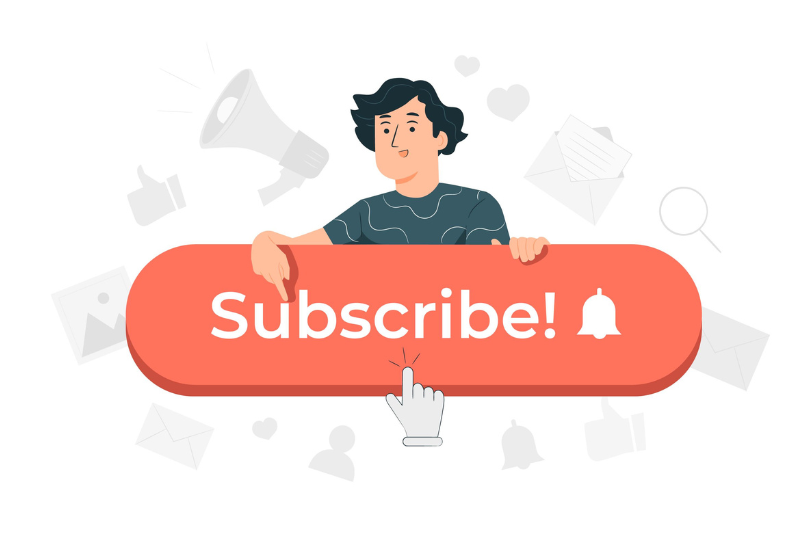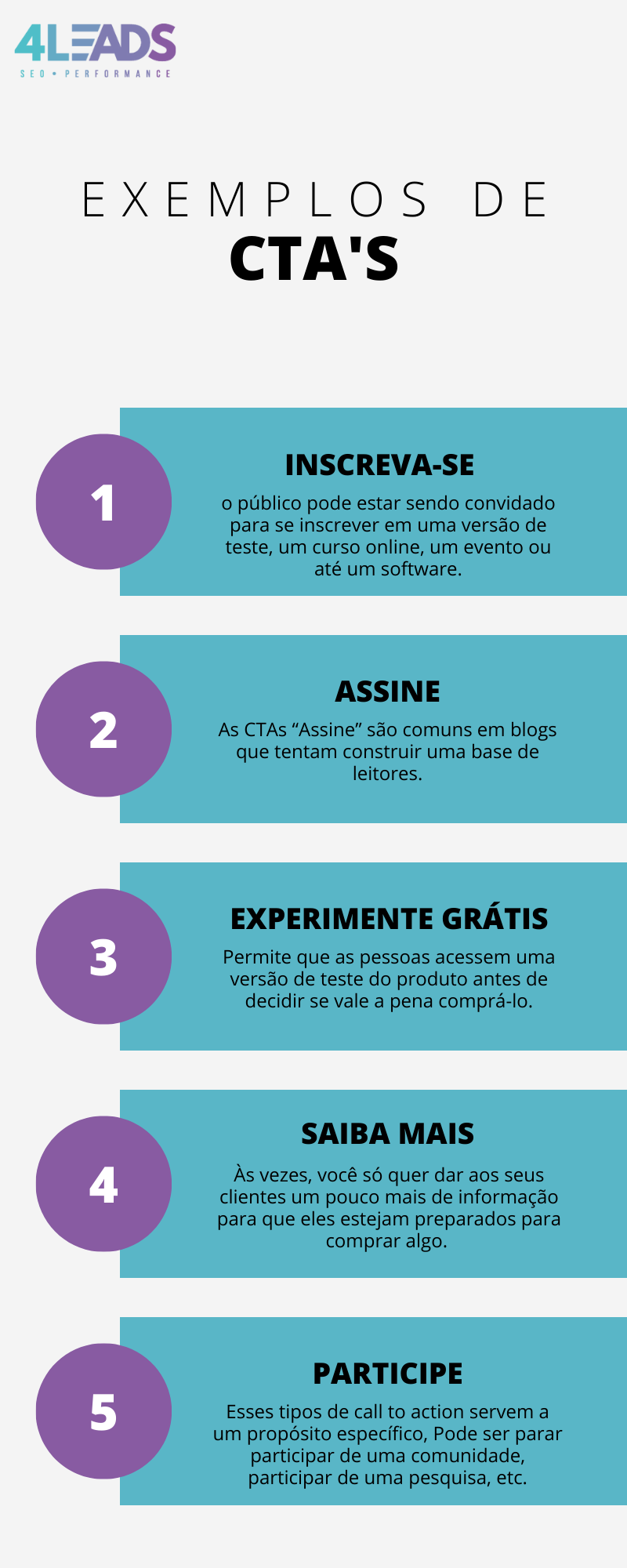
Have you ever realized how many times you've signed up for something online or clicked a button to request a service, talk to a seller, or download a resource? These actions are taken because you were influenced by the Call to Action (CTA).
In some way, you felt persuaded to take a specific action. This is the main feature of this digital marketing strategy. Without it, the chances of users taking action are very slim. After all, the CTA also serves as a path for the person to get what they want.
For example, when downloading an ebook, you first need to click on a link to open the landing page. After that, the user is directed through the content and the CTA to click the button and download the resource.
So, as you can see, the call to action appears at different moments.
In this case, it may appear where the ebook was offered (email marketing, social network, banner within a site, or in a blog text). It was also made within the ebook's landing page for you to take the action to download the material. The journey brought you to this moment, right?
Inserting a CTA at the beginning of an email marketing campaign increases the click-through rate by 24.28%, according to data from Resultados Digitais.
We've prepared this article for you to understand:
Keep reading and clear up all your questions on the topic!
The CTA is a crucial part of any marketing strategy. It plays an essential role in guiding your site or campaign visitors to take the desired action. These actions include making a purchase, signing up for a newsletter, requesting a quote, and filling out a form.
The importance of the CTA can be better grasped through a simple analogy.
Imagine you're watching a movie in a theater. You're engrossed in the plot, emotionally involved with the characters, and curious about the story's outcome. However, at the movie's end, there's no clear sign that you must leave the room. There isn't an exit door marked nor a notification that it's time to leave the theater. In this situation, you'd be left confused, unsure of which action to take next.
Now, think of the CTA's importance as the theater's exit sign. Just as the exit sign indicates the path to be followed after watching a movie, the CTA guides your site or campaign visitors on the action they should take.
It provides clarity and direction, removing any ambiguity and helping visitors move to the next step in the sales funnel.
See below for an example of types of call to action.

Having good calls to action offers numerous benefits for your marketing strategies. Let's explore some of them!
A compelling CTA has the power to guide visitors to take the desired action, whether it's making a purchase, subscribing to an email list, downloading an eBook, and more. By crafting appealing, persuasive, and well-placed calls to action, the chances of converting visitors into leads and customers can be significantly enhanced.
The CTA encourages the user to engage with the company by clicking a button, filling out a form, or performing a specific action. This strategy can also prolong the duration of a visitor's stay on the site, promote interactions, and strengthen the relationship with the audience.
When a website features prominently placed and highlighted CTAs, it becomes easier for users to navigate the pages intuitively. They act as guides, indicating to visitors the following steps to be taken, as we previously explained.
A strategically positioned CTA at different stages of the sales funnel aids in guiding visitors progressively toward conversion.
For instance, an initial call to action might encourage downloading free content, while the next could invite visitors to schedule a demonstration or purchase.
By guiding visitors at each stage of the funnel, the efficiency of the conversion process is heightened.
CTAs also assist in tracking the number of clicks, conversion rates, engagement, and other critical metrics for assessing the success of strategies. With this data, it becomes possible to make adjustments and optimize the calls to action based on real-time data, continuously improving outcomes.
Now that you understand the importance of this strategy and its benefits, it's time to delve into various ways to position your calls to action.
When we talk about "above the fold" on a website, we're referring to the immediately visible area of the page before the user has to scroll down.
Positioning the call to action above the fold means placing it in a spot that is instantly visible without scrolling as soon as the user lands on the page. This is essential because the first impression is pivotal and can determine whether the user takes the desired action or not.
Adopting this positioning increases the chances of capturing the visitor's attention and encouraging immediate action.
A potent strategy for positioning the CTA is at the end of the content, serving as a form of "conclusion." After providing persuasive and relevant information throughout, the call to action at the end acts as an invitation to the desired action.
This approach capitalizes on the engagement the visitor has already committed to while consuming the content, offering a seamless transition to the next step. This allows the company to convert that engagement into a tangible conversion.
When visitors reach the content's conclusion, they've invested time and interest in reading and are more receptive to further action.
By delivering a pertinent and compelling CTA at the end, one can harness this engagement and prompt the visitor to undertake the desired action. This could be filling out a form, making a purchase, requesting a quote, signing up for a newsletter, among others.
Positioning the call to action at the content's end avoids interrupting the content's flow. Visitors get to soak in all the salient information before being prompted to act.
However, to be truly effective, the call must be clear, targeted, and relevant to the preceding content.
A floating, fixed, or scrolling CTA remains visible as the visitor scrolls down the page. This strategy brings unique advantages to your conversion campaigns.
Such a call to action offers heightened visibility and can catch the visitor's eye as they scroll, urging them to act.
When adopting this strategy, it's crucial to balance visibility and intrusiveness.
A highly intrusive call to action might come off as annoying or disruptive, negatively impacting the user experience. On the flip side, a CTA that isn't visible enough may go unnoticed, failing to incite the desired action.
Thus, one must first and foremost consider the page's purpose and the user's journey. If the primary goal of the page is immediate conversion, such as selling a product or subscribing to a service, a floating CTA might be more effective in ensuring the call is always visible and ready for action.
However, if the objective is to furnish detailed information about a product or service, a discreet fixed CTA might be more fitting, letting the visitor focus on the content and make an informed decision when they're set.
This kind of call to action seamlessly fits into the context and structure of the content. Rather than being an overt interruption or a separate entity, the CTA is subtly and naturally incorporated, becoming an extension of the content and complementing the conveyed message.
This ensures the call is more relevant and appealing to visitors, boosting conversion chances.
The call may be placed at the end of a section setting the stage for action or after delivering information that piques the user's interest and need.
A contextual CTA might invite visitors to download an eBook related to their reading content, offering additional pertinent information.
Now, why shouldn't you forgo calls to action in your digital marketing strategy? They are the triggers that prompt the user to make a purchase, speak to a salesperson, learn more about a topic, sign up, or download, among other actions.
Thus, you stand a higher chance of obtaining conversions from qualified leads and, consequently, more significant sales opportunities.
For powerful CTAs that truly convert, rely on our team's expertise!
We thoroughly study the persona and the company to grasp how strategic planning should be carried out. We craft valuable content tailored to the persona's stage.
We boast a highly skilled team equipped to deliver the desired outcomes and meet the set objectives. Speak to one of our consultants to learn about our methodology and how your management can benefit from it!
Find us on LinkedIn, where we regularly post terrific content on digital marketing and technology!